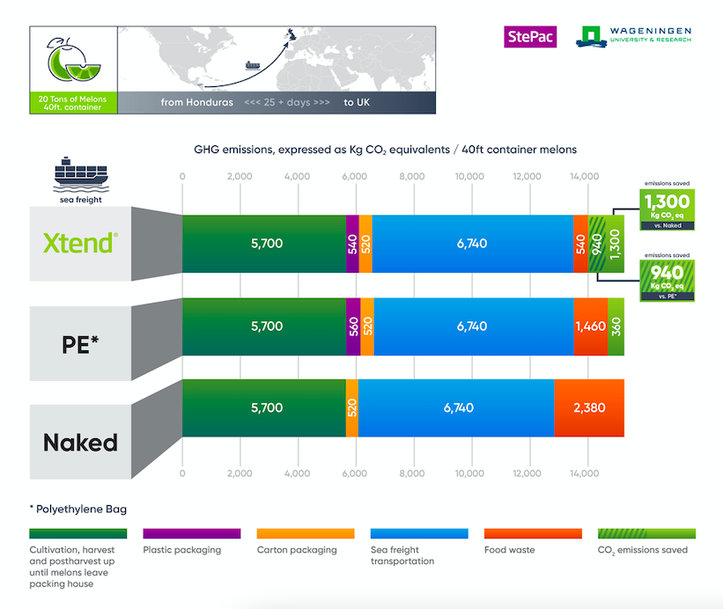www.industryemea.com
27
'23
Written on Modified on
Wageningen University Study Finds StePac's Packaging Reduces Greenhouse Gas Emissions
Addressing the need for extensive reduction of greenhouse gas emissions, StePac, L.A. Ltd, analyzed supply chains it is closely involved with to assess how its advanced packaging preserves quality of fresh produce during handling, shipping, and storing, and by doing so reduces waste and saves GHG emissions.

The sustainable shelf-life extension packaging experts commissioned researchers at Wageningen Food & Biobased Research facility, Netherlands, to quantify the GHG emissions associated with the use of its Modified Atmosphere (MAP) products across numerous supply chains worldwide. Results exceeded expectations, with the MAP products demonstrating abilities to reduce CO2 emissions dramatically.
The recent spate of global weather events, from crippling droughts to European heat waves, has pushed climate change worries to the very forefront of consumer concerns. CO2 emissions are recognized as the leading GHG implicated in climate change. Moreover, food waste is a second major concern of today’s eco-savvy consumers, yet few discussions of food waste focus on its negative impact on GHG emissions.
“Food waste contributes c.8% of all GHG emissions associated with climate change, the biggest threat to our planet,” “By creating sustainable modified atmosphere packaging solutions which extend produce freshness often by 50-100%, StePac has demonstrated through this research, that it helps lower GHG emissions by reducing waste in the fresh produce supply chain and often facilitating sea transport instead of air transport of produce to distant destinations. The reduction in GHG emissions far exceeds those generated in the full lifecycle of the packaging itself,” states Gary Ward, PhD, Business Development Manager for StePac.
Jan Broeze, PhD, Senior Scientist of Sustainable Food Chains at the Wageningen Food & Biobased Research, has developed a “field to fork” calculator to estimate greenhouse emissions associated with different aspects of fresh produce production and shipping. Calculations took into consideration the GHG emissions associated with the different plastic packaging solutions throughout the lifecycle including the end-of-life (incineration, landfill and recycling).
It also included data provided by StePac pertaining to waste reduction based on research and commercial experience. Nine scenarios were examined, including melons from Honduras to the UK (Xtend® Bulk), blueberries from Peru to China (XflowTM), stone fruit from Spain to Brazil (Xtend bulk), and broccoli shipped domestically in Brazil (XgoTM Retail).
Foremost, the results showed that GHG emissions related to plastics production, use and end-of-life are relatively small compared to other GHG emissions along the food supply chain. For example, in the shipping of melons from Honduras to UK, the cultivation, harvest, and postharvest handling represented 41% of the total GHG emissions of 701kg CO2/ton of melons.
Transportation represented 48% of the GHG emissions. On the other hand, Xtend packaging represents only 3% of the total CO2 emissions and the end-of-life represents only 1% of the total CO2 emissions yet contributed significantly to reducing CO2 emissions by minimizing waste. This was typical of all of the scenarios evaluated.
In one example, shipping unwrapped Galia and Cantaloupe melons from Honduras to the UK in 25+ days, resulted in a high waste of nearly 18%. Due to its low water-vapor transmission rate (WVTR), polyethylene packaging with MAP properties is unsuitable and can result in waste levels of 12.5% or greater, mainly due to microbial decay.
The use of Xtend packaging with relatively high WVTR levels that eliminate excess moisture plays a key role in reducing the waste in sea freight to a minimum of less than 3.5%. This reduction in waste, when compared to polyethylene packaging, represents a reduction in 6% of the GHG emissions or 940kg CO2 equivalents per container loaded with 20 tons of melons. In tangible terms, shipping four containers of melons in Xtend saves the equivalent annual CO2 emissions produced by an average vehicle, estimated at 3020 Kg.
“Global warming poses some of the greatest risk to the health of the planet we live on,” states Ward. “In order to combat it, we need to reduce GHG emissions. The outcome of this research demonstrates the value of our bulk and retail packaging in doing so by reducing waste in the fresh produce supply chain and facilitating sea as an alternative to air freight. Based on the research, StePac estimates that across all supply chains in which its packaging is used, it saved in excess of 100,000 tons CO2 emissions in 2022-equivalent to the annual amount produced by 31,000 automobiles.
“This research clearly shows that StePac’s MAP solutions for fresh produce can contribute to reducing global GHG emissions by facilitating sea freight and by reducing waste in the supply chain,” “The savings associated with their use far exceed the emissions generated in the life cycle of the packaging, establishing that they have a positive environmental impact,” attests Broeze.
Meet us at Fruit Logistica 2023, Berlin, February 8-10, hall 5.2, booth #C-30.
www.stepac.com

